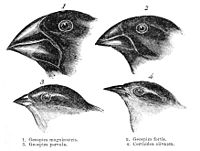
Photo from wikipedia
Better characterization of the sources of phenotypic variation in human behavioural traits—stemming from genetic and environmental influences—will allow for more informed decisions about how to approach a range of challenges… Click to show full abstract
Better characterization of the sources of phenotypic variation in human behavioural traits—stemming from genetic and environmental influences—will allow for more informed decisions about how to approach a range of challenges arising from variation, ranging from societal issues to the treatment of diseases. In particular, understanding how the environment moderates genetic influence on phenotypes (i.e., genotype–environment interactions, or G × E) is a central component of the behavioral sciences. Yet, understanding of this phenomenon is lagging somewhat, due in part to the difficulties of detecting G × E. We discuss the logic behind one of the primary ways to detect G × E: comparing heritability estimates across environments. Then, we highlight some pitfalls, with an emphasis on how very strong G × E can sometimes be undetectable using this method when high heritability is present in multiple environments. We conclude by forwarding some initial, yet tentative, suggestions for how best to address to the problem.
Journal Title: Behavior Genetics
Year Published: 2019
Link to full text (if available)
Share on Social Media: Sign Up to like & get
recommendations!